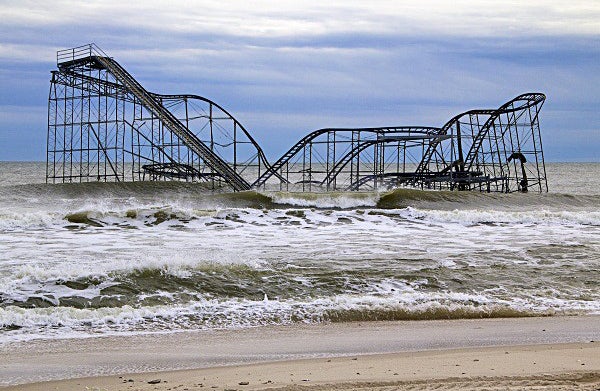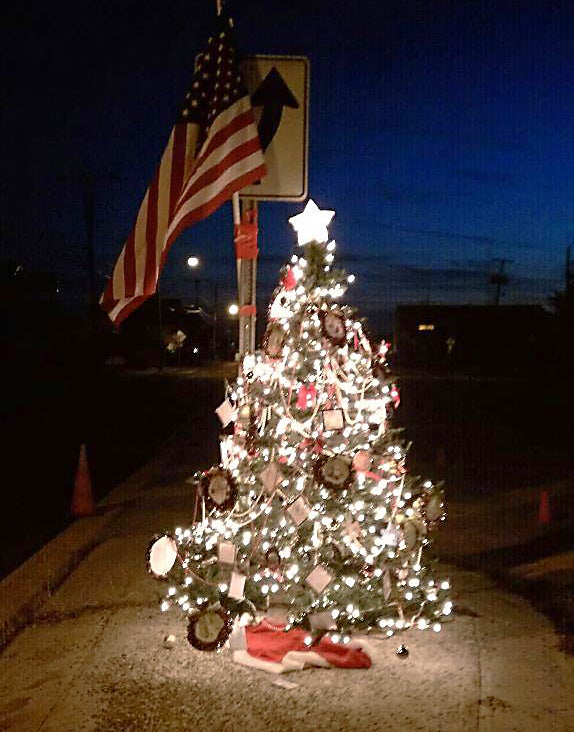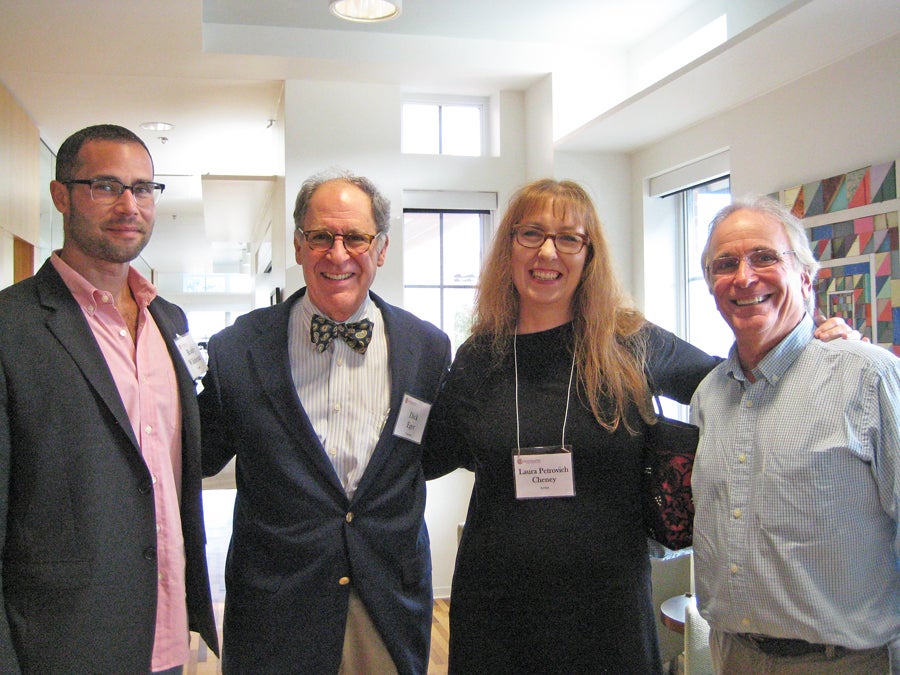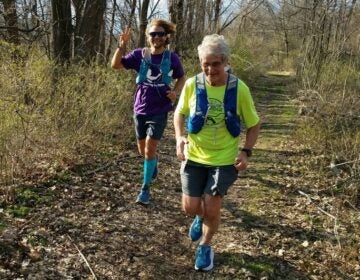Superstorm Sandy didn’t make heroes, it revealed them

The JetStar Roller Coaster fell into the ocean in Seaside Heights, N.J. during Superstorm Sandy. (Jana Shea/for NewsWorks)
Two years ago today, Superstorm Sandy made landfall in New Jersey. The storm caused close to $62 billion in damage, making it the second-costliest weather disaster in the nation’s history, next to Hurricane Katrina. It damaged at least 650,000 homes and affected over 300,000 businesses. While the storm drastically changed the landscape of many coastal towns, it also gave some people a new direction to their lives that gave their own lives a sense of purpose and mission.
NewsWorks spoke with three people whose lives changed forever when Sandy hit. Courtney Chibbaro used the first Christmas after the storm as an island-wide reminder of the power of community. Debbie Houlihan felt, for the first time in her life, that she had a calling in life to organize relief efforts through her church. Dick Eger visited storm-battered artist studios in search of work that resonated with the personal and shared experience of the storm.
These three people see Sandy as a pivot point, an event that changed the way they think, act, and approach their lives and others.
A Christmas to remember
Courtney Chibbaro remembers those surreal, sleepwalking weeks in Sandy’s  wake, just after the storm ripped up the coast, upheaving her neighborhood in South Seaside Park, on the northern barrier island in Ocean County, N.J. It wasn’t until two weeks later that she was allowed to return to her home with a single suitcase to pack up essentials and survey the damage.
wake, just after the storm ripped up the coast, upheaving her neighborhood in South Seaside Park, on the northern barrier island in Ocean County, N.J. It wasn’t until two weeks later that she was allowed to return to her home with a single suitcase to pack up essentials and survey the damage.
“We arrived at about five in the morning, and you had to get a number, and it was our first time seeing everyone, our neighbors…” Courtney recounted. “And we were all upset and worrying about what we were going home to. And we took a bus over and…it was a bus ride to never be forgotten.”
That moment, when the bus reached the bridge, was the shifting point for Courtney. She still remembers the sudden, consuming lull that fell over her neighbors the moment they saw what was left of their town.
“At the end of the day, we didn’t put anything in our suitcases because it just kind of…nothing really mattered once we got there.”
Courtney Chibbaro was lucky, even if she didn’t realize it at the time. She was in her late twenties and enjoying her job as an elder care case manager in Tom’s River, N.J. But once Sandy hit in late 2012, she naturally – and unexpectedly – snapped into the role of a community organizer.
“I’m a real sucker for Christmas,” Courtney laughed. “Really, if I could celebrate it 12 months a year I would! And I just couldn’t believe the thought that people wouldn’t be able to have their children wake up in their homes.”
So, less than two months after the storm, Courtney did the unimaginable. She brought Christmas back to the barrier island.
It started, as many things do these days, with a Facebook post gone rogue. Courtney called on her friends to bake cookies and make cards for people in her neighborhood, but in the next few hours she received an outpouring of messages from all over the country. And then the mail started – cards and presents and letters from Nevada and Kentucky and Missouri and Texas – which ended up filling a 26-foot U-Haul.
“And we ran an extension cord and put a Christmas tree in the middle of route 35!” Courtney recounted in a gush of excitement. “And we lit it up! Hell or high water, we were having Christmas on the island!”
Courtney lost her job in elder care the day after Christmas. But, strangely, she wasn’t too shaken. She had made contact with lots of volunteer groups and local politicians in the run-up to the holidays, so it was a natural leap to launch into full-time volunteering. She is now the disaster case manager at The People’s Pantry in Toms River, where she has fought for and secured supplemental aid packages and extensions for AmeriCorps volunteers. Every day she works with people to help them through the process of rebuilding homes, relocating, navigating grants, and figuring out long-term plans.
“I’ve literally seen people take shirts off their backs, food out of their cabinets, money out of their wallets,” Courtney said. “People lost a lot of dignity because it’s a lot of middle class America that’s been turned upside down and they’re not used to asking for help. But it’s a common understanding that we have now amongst each other of – listen, you’re not going through it alone.”
It’s easy to see that Courtney was always one to look for silver linings, but she managed to find one even in the darkest storm to pass over the shore.
“It’s the craziest thing but…Hurricane Sandy gave me a confidence that I never had before. If you believe in something and give yourself a voice, your community will stand behind you and you can accomplish anything.”
Contact The People’s Pantry Relief Center in Toms River, N.J., to get involved: (732) 908-9835.
———————-
Being called upon to act
Debbie Houlihan was at her home in Manalapan, N.J., when Sandy hit, but as soon as the roads were clear she headed down to her church in Point Pleasant. Damaged beach mansions, totaled ranches: the storm was indiscriminate, and the only discernible difference between each home was the size of the rubbish pile at the curb.
as the roads were clear she headed down to her church in Point Pleasant. Damaged beach mansions, totaled ranches: the storm was indiscriminate, and the only discernible difference between each home was the size of the rubbish pile at the curb.
Debbie remembers a foul stench in the air, a mix of gasoline, sewage, and the sea.
“I met a woman who had fish swimming in her house, deposited there from the nasty storm surge,” Debbie wrote in an email to NewsWorks. “I remember seaweed hanging off the rooftops from the ocean waves crashing over the houses at the shoreline area.”
The same scenes were playing out in shore towns across the state. People had lost their homes and possessions, and, for those whose work depended on tourism, their jobs.
Many churches in the area sprang into action, including Good Shepherd Lutheran Church in Point Pleasant. Debbie became involved in organizing clothing drives, providing meals, and bringing in supplies to help with flood recovery. “Her official title through the church became the Sandy Response Team Resource and Outreach Coordinator, but some people know her as ‘everyone’s mother.'”
Debbie had been an active member of churches long before Sandy imposed unprecedented needs on her community. She led youth groups and Bible studies, taught Sunday School, and served on church councils. But the storm made her a more missional Christian. When Sandy hit, it was the first time she truly felt called.
“I would wake up in the middle of the night with my mind flooded with ideas and plans,” Debbie described. “I would drive down to the shore areas to help every morning, and then head home at the end of the day exhausted and moved to tears from all the sadness I witnessed, only to return the next day and repeat the cycle all over again. I just couldn’t stay away.”
The daily observations of suffering were almost unbearable at times, but Debbie says her faith in the Lord gave her the strength to keep going.
“I have experienced so many ‘timely coincidences’ I like to call ‘God-sightings,'” she wrote. “I feel sure of His presence among us.”
Although church attendance did peak for some time after the storm, Debbie says the uptick faded as time went on. And while the storm continues to recede into distant memory, the road to recovery looms long for most people. Now that her church is a more familiar name in the community, people continue to call on her for help and resources.
More than anything, Debbie says the storm restored her faith in the intrinsic goodness of people. Community members of all denominations worked together to coordinate relief efforts, bringing a new sense of cohesiveness to the entire religious community.
“It has been said that a crisis doesn’t create heroes, it simply reveals them,” she wrote. “I have watched in awe as people have stepped up, seemingly out of nowhere, and made such an impact, giving their time, talent, and finances to touch the lives of strangers in need.”
Anyone interested in helping with rebuilding can contact the Ocean County Long Term Recovery Group: (732) 569-3484. Food donations will be gratefully accepted by Ocean County Hunger Relief, which supplies 26 faith-based pantries, and the food Bank of Monmouth and Ocean Counties.
————————
Finding artists to say what we feel inside
The weeks and months immediately after the storm were all sirens and dump trucks, flood buckets and rubble. But after the dust settled, Dick Eger traveled from his Morristown home, in Morris County, N.J., to the shore in search of artists with a story to tell.
trucks, flood buckets and rubble. But after the dust settled, Dick Eger traveled from his Morristown home, in Morris County, N.J., to the shore in search of artists with a story to tell.
Dick recently stepped down after 19 years on the board of the Morristown Arts Council. His day job is managing investment portfolios at Merrill Lynch but he still makes time to curate shows. His most recent curatorial work is now on view at the Morris Arts Gallery in a show aptly titled, “Sandy: Destruction/Constructions.”
He says that it wasn’t until February of this year that the idea for a hand-picked, Sandy-driven show emerged.
“When most people are faced with the stress and the trauma of catastrophe, they’re not going to think about art the first thing,” Dick admitted. “The difference is that artists do; it is what they live and breathe every day. This is part of their life, and for many of them, one of the first things they thought of was – how can I take this and translate it into something valuable?”
That’s what the four artists included in the show asked themselves, and Dick believes they each arrived at a meaningful expression of their experience of Sandy.
There’s Laura Petrovich-Cheney, who salvaged wood from the wreckage and transformed it into wall sculptures in her Asbury Park studio. Roddy Wildeman, a Belmar artist, harvested the wood flotsam and jetsam from people’s homes and meticulously constructed and labeled them in his pieces. Bruce Perlmutter, a woodturner from Red Bank, created elegant vases, bowls and plates from found wood. And Monmouth County photographer Kevin Burkitt photographed post-Sandy landscapes at night with an almost obsessive dedication to create a series of desolate long-exposures.
Dick has noticed a surge in public interest in the arts since Sandy, which he credits to locality. The storm influenced an influx of small, local gallery shows that were both accessible and relevant to viewers.
“I think it’s something that is now being felt by a lot of people who didn’t notice art, didn’t think about art,” said Dick. “Now, more than ever, it seems art is a much bigger part of their lives.
Dick says there are two pieces that really capture the spirit of the show – one is a picture of a garage with all of the doors askew, filled with refuse and sand. That picture appears in the gallery next to a wooden sculpture constructed from refuse.
“Those two pieces, side by side, almost tell you everything,” said Dick. “It’s as if one is transformed into the other.”
“Sandy: Destruction/Constructions” is now on view at the Morris Arts Gallery at 14 Maple Ave, Morristown, NJ. The gallery is open to the public Mondays – Thursdays, 10am to 4pm, and Fridays from 10am to 1pm.
WHYY is your source for fact-based, in-depth journalism and information. As a nonprofit organization, we rely on financial support from readers like you. Please give today.




